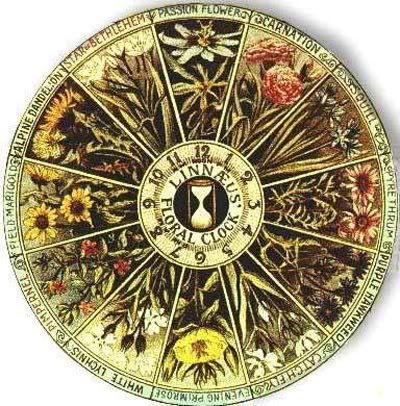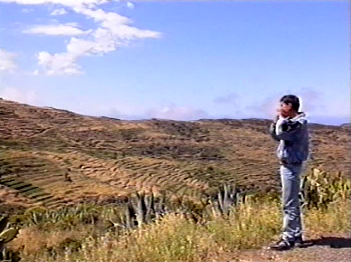Wednesday, July 8, 2009
It's back!
This is the spiritual successor to kirchersociety.org, operated by the same people. It appears to be more oriented on curiosities that can be pinned on a globe, so I figure it won't have things like Vegetable Animals, the Kaye effect or Prince Rupert's drops.
Anyhow, while I was laboring under misapprehension that the Kircher Society was wholly defunct, Joshua Foer was operating Curious Expeditions, which is like KS.org and Atlas Obscura, but more informal and sassy. I've got a lot of reading to do.
Point is, I think we're done. There isn't a need for I Miss Kircher Society Dot Org Dot Blogspot Dot Com anymore.
The Cynosphere

The cynosphere, a French tricycle powered by dogs, built in 1875.
[Taken verbatim from the original kirchersociety.org]Wednesday, July 1, 2009
Linnaeus' Flower Clock

Carl Linnaeus, father of taxonomy, divided the flowering plants into three groups: the meteorici, which change their opening and closing times according to the weather conditions; the tropici, which change their opening and closing times according to the length of the day; and the aequinoctales, which have fixed opening and closing times, regardless of weather or season.
Linnaeus noted in his Philosophia Botanica that if one possessed a sufficiently large variety of aequinoctal species, it would be possible to tell time simply by observing the daily opening and closing of flowers. Though Linneaus seems never actually to have planted an horologium florae, or flower clock, his plan was taken up with great passion by many 19th-century gardeners, who often arranged a dozen or more species in the manner of a circular clock face. Below, the approximate opening and closing times of aequinoctal flowers that can be used in an horologium florae:
0200 – Night blooming cereus closes
0500 – Morning glories, wild roses
0600 – Spotted cat’s ear, catmint
0700 – African marigold, orange hawkweed, dandelions
0800 – Mouse-ear hawkweed, African daisies
0900 – Field marigold, gentians, prickly sowthistle closes
1000 – Helichrysum, Californium poppy, common nipplewort closes
1100 – Star of Bethlehem
1200 – Passion flower, goatsbeard, morning glory closes
1300 – Chiding pink closes
1400 – Scarlet pimpernel closes
1500 – Hawkbit closes
1600 – ‘Four o’clock’ plant opens, small bindweed closes, Californian poppy closes
1700 – White waterlily closes
1800 – Evening primrose, moonflower
1900
2000 – Daylilies and dandelions close
2100 – Flowering tobacco
2200 – Night blooming cereus
[Taken verbatim from the original kirchersociety.org]
Tuesday, June 30, 2009
The Arrow Stork of Mecklenburg

Until the 19th century, the sudden annual disappearance of white storks each fall had been a profound mystery to European bird-watchers. Aristotle thought the storks went into hibernation with the other disappearing avian species, perhaps at the bottom of the sea. According to some fanciful accounts, "flocks of swallows were allegedly seen congregating in marshes until their accumulated weight bent the reeds into the water, submerging the birds, which apparently then settled down for a long winter’s nap." A 1703 pamphlet titled "An Essay toward the Probable Solution of this Question: Whence come the Stork and the Turtledove, the Crane, and the Swallow, when they Know and Observe the Appointed Time of their Coming," argued that the disappearing birds flew to the moon for the winter.
On May 21, 1822, a stunning piece of evidence came to light, which suggested a less miraculous, if no less wondrous, solution to the quandary of the disappearing birds. A white stork, shot on the Bothmer Estate near Mecklenburg, was discovered with an 80 cm long Central African spear embedded in its neck. The stork had flown the entire migratory journey from its equatorial wintering grounds in this impaled state. The Arrow-Stork, or Pfeilstorch, can now be found, stuffed, in the Zoological Collection of the University of Rostock. It is not alone. Since 1822, some 25 separate cases of pfeilstorches have been recorded.
[Taken verbatim from the original kirchersociety.org]
Tuesday, June 23, 2009
Capgras Syndrome – "This is not my beautiful house! This is not my beautiful wife!"
The disorder was first described in 1923 by the French psychiatrists Joseph Capgras and Jean Reboul-Lachaux. They treated a 53-year-old who believed that her husband, her children, her neighbors and even she had been replaced by exact “doubles” in a plot to steal her property.
In Capgras, there is an uncoupling of perception and recognition that leads many investigators to theorize that there may be a neurological, organic cause that remains unknown. Psychoanalysts have seen Capgras as an unusual form of displacement in which the patient rejects the loved one whenever negative features have to be attributed.
Apparently, in some cases it even leads a sufferer to believe he or she is being replaced. An in-depth case study (PDF) relays a transcript between an experimenter and a patient, named DS:
E (Pointing to a photograph of DS from two years ago when he had a moustache): 'Whose picture is this?'
P: 'That is another DS who looks identical to me but he isn't me—he has a moustache.'
Of course, all this does is make me think of The Talking Heads' "Once in a Lifetime". Same as it ever was.
Saturday, June 20, 2009
Alphabet agates

These agates, from the island of Java, are colored by deposits of iron oxide. Gem-cutters of incredible skill make a few preliminary cuts to try and determine the nature of the reddish-brown ribbons. This is difficult, because the agate is totally opaque, so any cut will be based on an educated guess at best. From there, they cut the stone into a cabochon (oval or spheroidal shape) and, if the gem-cutter is lucky, the ribbon of colored agate will behave as predicted, and a pretty shape will reveal itself. Letters appear to be the most popular cabochon pattern, and the most common letter agates are the simple cross shapes, like X and T. R is allegedly the most difficult to find. According to this website, which is selling a complete set of alphabet agates for over eleven thousasand USD, there are only eight known complete sets in the world.
I have a hunch that the only reason these collections are so rare and expensive is that the production is done in rural Indonesia with a technique that is steeped in tradition and mystery. I say that there must be some way to x-ray the agate prior to cutting into it, so that we may fully map out where the coloration is. Then, we can run some program to identify where a desired pattern will appear with a certain level of accuracy. This would probably be a lot easier if we didn't restrict the final output to the convex cabochon shape.
If that works (which it might!) it would led to a whole field of custom agates, in shapes far more complex than letters of the alphabet. I know exactly what I would want...

Sunday, June 14, 2009
El Silbo Gomero (The Gomeran Whistle)
Imagine you're a shepherd, and, more importantly, you need to borrow some knives or something from your neighbor. The only problem is that your neighbor is also a shepherd, and there are about a thousand places he could be. You could spend all night yelling and not find him! Moreover, to even get close to him would mean descending a long footpath, ascending another one, and then wandering around his pastureland for an hour or so. And whether you find him or not, you'll have to go all the way back before your sheep do something stupid, like knock over a lamp or join a cult or whatever.
This was what the residents of La Gomera faced in their daily lives. To compensate, they developed a powerful solution, a system of instantaneous long-distance communication: el Silbo Gomero (Literally, "Gomeran Whistle"), a fully functional whistled dialect of Spanish. And it's awesome.

El Silbo has a well-known history. The original inhabitants of La Gomera were believed to be immigrants from part of what is now Mauritania, and they spoke a tonal language. Tones were so important to the phonology of the language that one could speak simple sentences with just the tones and not lose meaning. This rudimentary system evolved to include glides and stops to imitate consonants, which let whistlers convey more complex phrases. In the 16th century, when the Spaniards conquered the island, the natives were driven to extinction. But the Guanches, Spanish immigrants, adapted the Gomeran whistle to their native Spanish. Spanish does not have phonologically significant tones, so pitch variations are used to represent vowels. The system worked great for the shepherds and farmers. In the 1990's, when modernization brought the number of whistlers to a dangerous nadir, the government of La Gomera made el Silbo a mandatory subject for elementary students, which successfully sparked a whistling renaissance.

Now, this isn't the only whistled language. There are literally hundreds more. Most, if not all, arose as a means of addressing the problem of communicating over long distances, where yelling was no longer viable. Whistled languages were prevalent in three different types of land:
- Mountains, where steep slopes or heavy snows left people physically isolated even if they could see each other. Some examples of mountain whistle languages are Aas, from the French Pyrenees (which went extinct in the 70's); Chepang, from the Nepalese side of the Himalayas; and yes, Silbo Gomero.
- Jungles, where the dense flora restricted sound propagation. For hunting groups, good communication is vital, and whistles can travel over six times farther than hollers while still remaining coherent. Examples of jungle whistled languages are Pirahã, Gasup from Papua New Guinea, and the Mazatecan languages of Central America. I have a completely unfounded hunch that being descended from a whistling culture is the reason why seemingly everyone in Oaxaca today is a master whistler.
- Deserts. Specifically, West Africa. This same region is also known for the talking drum. Also, they may be descended from the same tribes that were the first to colonize (and whistle on) La Gomera. Examples of desert whistled languages—well, when I said above that there were literally hundreds of whistled languages, I didn't mention that most of them are from West Africa. There are too many for me to even begin.
- There's also the village of Kuşköy in Turkey. I don't actually know the lay of the land around there, so I don't know if it even fits into one of the above categories. Regardless, it's probably the second-most thoroughly documented whistled language after el Silbo, so I feel it deserves a mention.
Jeff Brent has the most complete English collection of resources on the language, including a self published book and a handful of authorized translations. The government of La Gomera offers a bunch of educational resources on el Silbo (in Spanish, natch). They have a set of three videos that they offer to universities. In winter of 2007-2008, I went to great lengths to convince them to a copy to me, a high school punk. A few weeks later, I received a slightly grainy PAL VHS, which I promptly converted to DVD. As far as I know, this is the only digital version of these videos in existence. I am presently debating whether or not to put them online. Those pictures you see above are stills from parte uno, which makes them an I Miss Kircher Society Dot Org Dot Blogspot Dot Com Exclusive (IMKSDODBDCE)!
And yes, I did originally learn about el Silbo from the old kirchersociety.org.